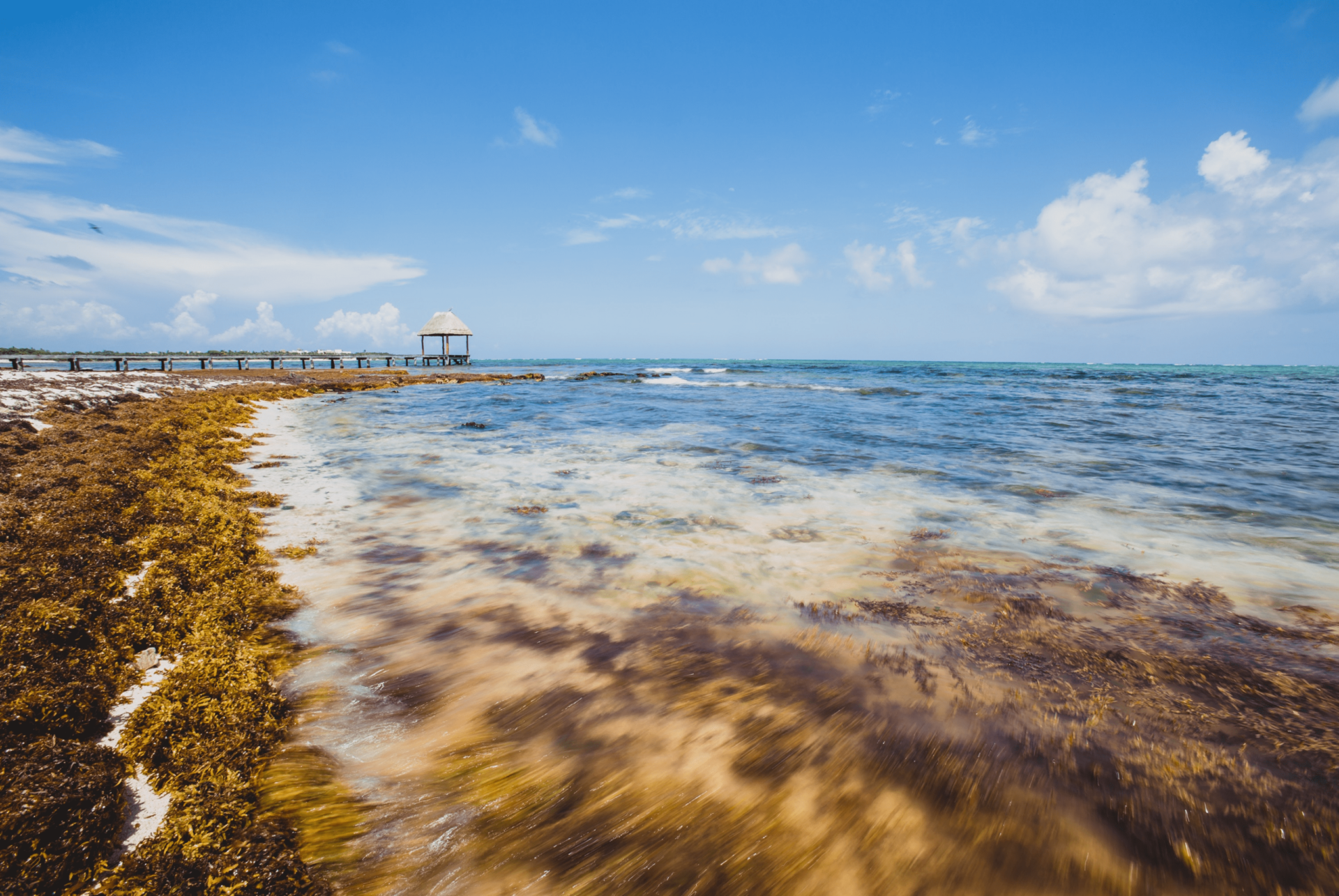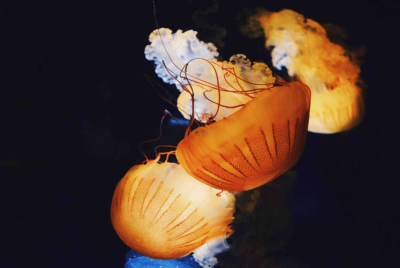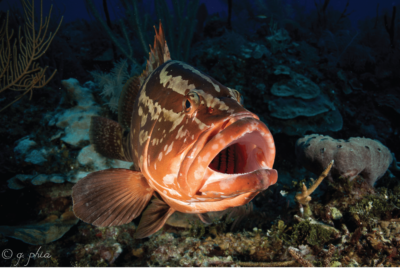Written by Nereus Research Associate Colette Wabnitz with Jimena Eyzaguirre and Ravidya Burrowes (ESSA Technologies Ltd),
Large Sargassum blooms and mass strandings started in earnest in 2011[1], [2] . That year the buildup of Sargassum – a type of large brown seaweed – at sea was 200-fold greater than the previous 8-year average[3]. During the bloom season (spring and summer) unprecedented masses of seaweed washed ashore in the Caribbean, piling high up on beaches, shading seagrass beds from the sunlight they need to thrive, entangling sea turtles[4], and decaying in shallow water or on beaches filling the air with a stench of rotten eggs. Whilst there have been Sargassum bloom episodes every year since 2011, 2015 saw the next large-scale event. In January 2018, unusually large aggregations of Sargassum could already be spotted on satellite imagery[5]. This year, the blooms are unprecedented in their duration, size and geographic scale, with reports of over 700 fouled beaches and disappointed tourists from Florida, Mexico and Belize to Barbados, via Cuba, the Cayman Islands, throughout the Lesser Antilles and south to French Guyana[6], [7]. The scale of this latest invasion led the government of Barbados to treat it as a national emergency[8]. In August 2018, Sargassum covered an area of 1,697 km2, compared to a historical average of 292 km2 between 2011 and 2017. By October, large amounts of seaweed continued to plague the region, but the overall bloom intensity had declined[9]; predictions suggest that most algae mats may finally have dissipated by December[10].
Sargassum out at sea – Sargassum close to shore
The irony is that out at sea large rafts of Sargassum provide important habitat to a wide range of species; it is only when close to shore in such massive quantities that it is a deathtrap for many animals and contributes to the degradation of important coastal habitats[11]. While there are a wide variety of different Sargassum species, only two are of interest here: Sargassum natans and S. fluitans. Unlike some of the other Sargassum species that have a phase attached to the sea floor and one where it floats at the surface, S. natans and S. fluitans are both only found in the open ocean. While floating offshore, the algae, which create rafts that can be 100s of kilometers long and several meters deep, provide refuge and food for a large diversity of animals such as small shrimp, crabs, juvenile sea turtles[12], seabirds[13], dolphinfish, jacks[14], marine birds and other critters. Because of this ecological importance, in the United States it was designated as Essential Fish Habitat. Such designation affords it special protection. However, once currents and winds move the weeds close to shore, the algae start to sink as wave action and rough bottoms burst their gas-filled bladders that normally make Sargassum float. As leaves break down the algae start to decay, creating an environment poor in oxygen. Animals trapped under or among the dense and heavy mats can neither escape nor breathe, and ultimately die. The decomposing mass, which can be several meters high, creates oily slicks in its wake and releases a foul odor. Lack of oxygen is also problematic for coastal habitats, such as coral reefs and seagrass beds, that support much of the diversity of life that tourists[15] enjoy and local communities depend on[16]. Shading caused by the large accumulation of vegetation is a further concern, because seagrass[17] and corals both depend on sunshine to function and grow.
Where does the Sargassum come from?
Recent evidence indicates the algae did not drift in from the Sargasso Sea in the North Atlantic as was first put forward, but instead originates from the equatorial Atlantic. Sargassum are a common feature in the Sargasso Sea and therefore the area has always been considered as the principal source of the seaweed. However, satellite imagery and ocean current information point to the North Equatorial Recirculation Region as the origin of recent mass blooms – north of the mouth of the Amazon, between Brazil and west Africa, in an area not previously associated with Sargassum growth[18], [19]. Hindcast models of Sargassum landfalls[20] and composition of Sargassum forms from net sampling spanning the western Atlantic north to the south Sargasso Sea provide further evidence that the invading seaweed did not come from the Sargasso Sea[21]: Sargassum natans VIII dominated the western tropical Atlantic, eastern Caribbean and Antilles Current; in contrast, S. natans I dominated the South Sargasso Sea. While the exact transport mechanisms are currently under investigation, it is clear that currents, winds and other factors may carry the algae into the Caribbean[22].
What triggers the mass blooms?
A number of factors including nutrients, rising sea temperatures and Sahara dust storms have been put forward as likely culprits. Mathematical models developed to analyze satellite imagery and detect floating algae (the Floating Algae Index (FAI)[23]), reveal that it is only in recent years that the area has seen the mass proliferation of Sargassum – satellite imagery from before 2011 shows the area to be ‘largely free of seaweed’. Rising sea temperatures[24] may in part have contributed to this trend by creating an environment favorable for the growth and proliferation of the algae. Nutrient inputs from the Amazon and Orinoco Rivers – from agriculture, poor land use and sewage treatment – together with reduced wind speeds have also been hypothesized to contribute to the increased growth in Sargassum20, as the algae’s productivity is typically nutrient-limited while in oceanic waters[25]. This assertion is linked in part to observations that large Sargassum accumulations in the Gulf of Mexico in the 90s could be traced back to higher nutrient loads discharged from the Mississippi River[26]. Increased iron deposition – an element found at concentrations that often constrain plant growth in the ocean – from dust blown in from the Sahara region is another factor put forward as plausibly contributing to the onset and rapid propagation of the blooms.
News coverage of the 2018 Sargassum blooms and the severity of associated complications due to beach inundation of massive amounts of the brown algae has been extensive. Using satellite imagery and modelled surface currents, researchers are able to track floating algae and forecast likely stranding events[27], [28]. Such a system allows local residents and policy makers to better prepare. More research is needed to determine the importance and contributions of individual triggers to the recent large-scale Sargassum proliferation. To this end, continuous and consistent observations from and across satellites[29] combined with models of wind and current patterns, as well as climate-induced changes in key ocean features (e.g., temperature, pH and nutrient dynamics), will be needed.
What can be done?
A number of strategies have been put forward to deal with the large accumulations of algae resulting from the mass blooms. Removal and burial of the algae as soon as it gets stranded beaches has been widely recommended[30]. While effective, such a method contributes to the destruction of sea turtle nesting habitat and beach erosion. A number of initiatives have been piloted to remove the seaweed while still at sea: through an extensive system of oil-spill containment booms for example or a conveyor belt system that loads the algae onto a boat[31]. Creative uses for the algae have also been encouraged, including using it for chipboard[32], mulch[33] and fertilizer[34]. Chemical compounds extracted from Sargassum may also find applications in pharmaceuticals and personal care, fish feed and fuel.
Several funding initiatives have recently emerged to stimulate innovative and preventative approaches. Antigua’s Department of the Environment, for example, has initiated a procurement process to find viable alternatives to collect Sargassum while at sea[35]. Mexico is hoping to build on the local success of its 27-km-barrier solution[36]. In June 2018, the former French Environment Minister presented a €10 million plan to help combat the problem in Guadeloupe[37]. The Inter-American Development Bank launched its Blue-Tech Challenge Programme in September 2018 to explore creative solutions to combat mass strandings[38].
In the future, integrated management approaches should support adaptation to such events. Continued improvements in forecast models should allow countries to respond more effectively and implement timely and adequate mitigation strategies and management plans. These would be supported by innovative solutions to remove Sargassum efficiently and with minimal harm to the environment, while also deriving some profits from the commercialisation of algae derivatives. Further efforts should support research and development and Caribbean countries should coordinate efforts and responses.







